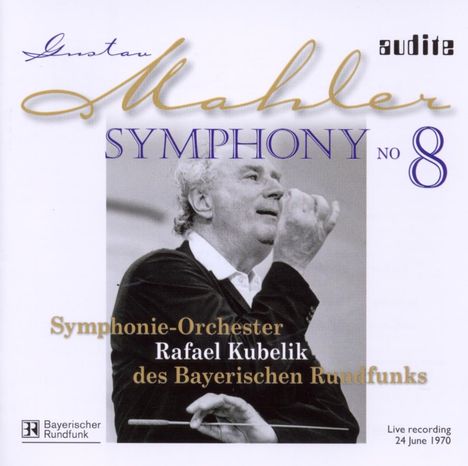Gustav Mahler: Symphonie Nr.8 auf CD
Symphonie Nr.8
Herkömmliche CD, die mit allen CD-Playern und Computerlaufwerken, aber auch mit den meisten SACD- oder Multiplayern abspielbar ist.
- Künstler:
- Martina Arroyo, Julia Hamari, Edith Mathis, Dietrich Fischer-Dieskau, Norma Procter, Franz Crass, Symphonieorchester des Bayerischen Rundfunks, Rafael Kubelik
- Label:
- Audite
- Aufnahmejahr ca.:
- 1970
- Artikelnummer:
- 4497980
- UPC/EAN:
- 4022143955517
- Erscheinungstermin:
- 14.5.2010
Die Sinfonie Nr. 8 ist Mahlers monumentalste, ist sie doch die Kombination zweier Chorkantaten gewaltigen Zuschnitts: Mahler verbindet den alten Pfingsthymnus von Hrabanus Maurus "Veni, creator spiritus" mit dem Schlussabschnitt des "Chorus mysticus" von Goethes Faust II. Unterschiedlicher könnten die Texte kaum sein und so stellt auch die Musik den Hörer vor höchst unterschiedliche Anforderungen: Der erste Teil der Sinfonie ist in sich geschlossen, die ekstatische Begeisterung des Hymnus wechselt mit innigen Passagen, um am Schluss den Bogen zum hymnischen Anfangscharakter zu schlagen. Der zweite Teil zur Vertonung des Faust-Textes ist nicht nur zweieinhalbmal so lang wie der erste Teil, sondern auch ungleich komplexer. Goethes esoterische Dichtung lässt auch Mahler in immer höhere Sphären aufsteigen dennoch wird seine Musik fast immer den Worten Goethes und der szenischen Beschreibung gerecht und Mahlers überirdische Visionen manifestieren sich in diesem gewaltigen Werk. Die Besetzung von einem 8-stimmigen Doppelchor, einem Knabenchor, 8 Solisten und der üppigen Orchesterbesetzung samt Orgel trugen der Sinfonie vor der Uraufführung den Beinamen "Sinfonie der Tausend" ein. Auch wenn Mahler auf der Streichung dieses Untertitels auf dem Werbeplakat bestand, drückt sich darin doch das Monumentale des Werkes gut aus. live-Aufnahme vom 24. Juni 1970 aus dem Kongreßsaal des Deutschen Museums.
Symphony No. 8 is Mahler's most monumental symphony, for it is itself a combination of two enormous choral cantatas in it, Mahler brings together "Veni, creator spiritus", the old Pentecostal hymn of Hrabanus Maurus, with Goethe's Faust II. The two texts could hardly be more dissimilar, which is why the music also makes very different demands on the listener in the two respective parts. The first part of the Symphony is complete in itself the ecstatic enthusiasm of the hymn alternates with intimate passages, then leading back to the opening hymn-like character at the end. The second part, a setting of the Faust text, is not only two-and-a-half times as long as the first but also far more complex. Goethe's esoteric poetry allows Mahler to ascend into ever higher spheres. However, his music almost always does justice to Goethe's words and the scenic description Mahler's celestial visions are manifested in this tremendous work. The ensemble, consisting of an eight-part double choir, a boys' choir, 8 soloists and a huge orchestra including organ earned the Symphony its nickname "Symphony of a Thousand" before its premiere. Even if Mahler insisted on crossing out this subtitle on the announcement poster, it does indeed express the work's monumental quality very well. live recording of 24 June 1970 in the Kongreßsaal des Deutschen Museums in Munich.
Disk 1 von 1 (CD)
Sinfonie Nr. 8 Es-Dur "Sinfonie der Tausend"
-
1 1. Allegro (1. Teil)
-
2 2. Poco adagio (2. Teil)
-
3 3. Äußerst langsam - Adagissimo
Mehr von Gustav Mahler
-
Gustav MahlerSymphonien Nr.9 & 10 (Adagio & Purgatorio)2 Super Audio CDsAktueller Preis: EUR 22,99
-
Gustav MahlerSymphonie Nr.82 Super Audio CDsAktueller Preis: EUR 22,99
-
Gustav MahlerDer Tod und das Mädchen für KammerorchesterSuper Audio CDAktueller Preis: EUR 7,99
-
Gustav MahlerSymphonien Nr.9 & 10 (Adagio)2 Super Audio CDsVorheriger Preis EUR 27,99, reduziert um 0%Aktueller Preis: EUR 10,99








